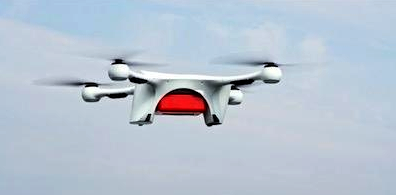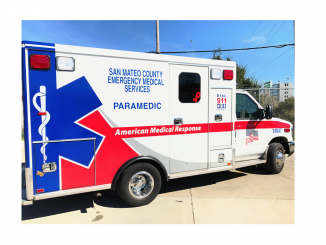
This story was originally printed Dec. 11 in the Daily Post.
BY ELAINE GOODMAN
Daily Post Correspondent
Drones might soon be buzzing overhead to deliver units of blood from Stanford Blood Center to Stanford Hospital, under a proposal the city of Palo Alto plans to send to the Federal Aviation Administration.
In a separate proposal, the city might use drones for such tasks as inspecting runways at the Palo Alto Airport, monitoring the airport perimeter or watching out for wildlife that could interfere with aircraft.
In addition, drones could be used in search operations or for utility inspections.
The city plans to submit the two proposals as part of a three-year FAA pilot program that President Trump announced in October. The idea is for local governments or states to partner with others to safely develop new uses for drones, which are also known as Unmanned Aircraft Systems, or UAS. The FAA will select five or more projects nationwide.
“Compared to manned aircraft, UAS provide novel, low-cost capabilities for both public and private applications,” Trump said in an Oct. 25 memorandum. “UAS present opportunities to enhance the safety of the American public, increase the efficiency and productivity of American industry, and create tens of thousands of new American jobs.”
An informational report on the drone pilot programs is included on the agenda for tonight’s City Council meeting. No council action is expected tonight.
Establishing a flight path
The first proposal is a partnership among the city, Stanford Blood Center and Matternet, a drone company based in Menlo Park. Drones would be used to bring units of blood to the hospital from the blood center in the Stanford Research Park in urgent situations, according to an overview of the project included in the report to council.
The project would involve establishing an approved flight path for the drones, which is expected to be west of Junipero Serra Boulevard.
“We are extremely aware and sensitive to the concerns of residents; every measure to eliminate intrusiveness and maximize safety will be taken,” according to the project overview.
Matternet has already been testing its drones in Switzerland for transporting blood and other medical samples between hospitals and testing labs. Another company, Half Moon Bay-based Zipline, is using drones to deliver blood products in Rwanda, working with 21 hospitals. It plans to provide a similar service in Tanzania, according to the company’s website.
Use by police and at the airport
Palo Alto’s second drone proposal would be a partnership with manufacturer Multirotor, a German company that has provided drone systems to the German army and Berlin Police Department. Multirotor recently opened offices in Redwood City.
In a project overview, Multirotor said it could work with Palo Alto to use drones in a variety of ways, such as in airport operations or by law enforcement, depending on the city’s interests.
A report this year from the Center for the Study of the Drone at Bard College found that 347 U.S. police, sheriff, fire and emergency response units had acquired drones between 2009 and early 2017. The report said that Texas and California were the states with the most publicly reported public safety drones, with 28 and 23 departments, respectively. In California, the departments include Menlo Park Fire and San Jose Police.
The Menlo Park Fire Protection District’s drone was used last month to help search for a suspect in the shooting of a transient man who lived in the marsh area southwest of the Dumbarton Bridge. The district’s drones were also used to help with the recovery efforts and investigation of the Wine Country fires.
Altitudes
Drones used in the FAA pilot programs would fly at an altitude of 200 feet or less; or up to an altitude of 400 feet with FAA approval. The proposals may potentially include drones flying beyond the operator’s line of sight or above populated areas.
Palo Alto has sent the FAA letters of intent regarding its two drone projects. The next step is for the full proposals to be submitted in stages, with a final proposal due on Jan. 4.
If the FAA selects Palo Alto’s project, the city would ask for City Council approval, notify the public and conduct any necessary environmental review, City Manager Jim Keene said in the report to council.
Concerns about safety, impact to the environment, neighborhood noise, and privacy would need to be first addressed, Keene said. Some might feel that the drones are a nuisance or threat, he noted. The city could withdraw from the pilot program at any time if the project was not working out.
The city’s role would be to facilitate the projects. Aside from time spent by city staff on the projects, there’s not expected to be any expense to the city.



